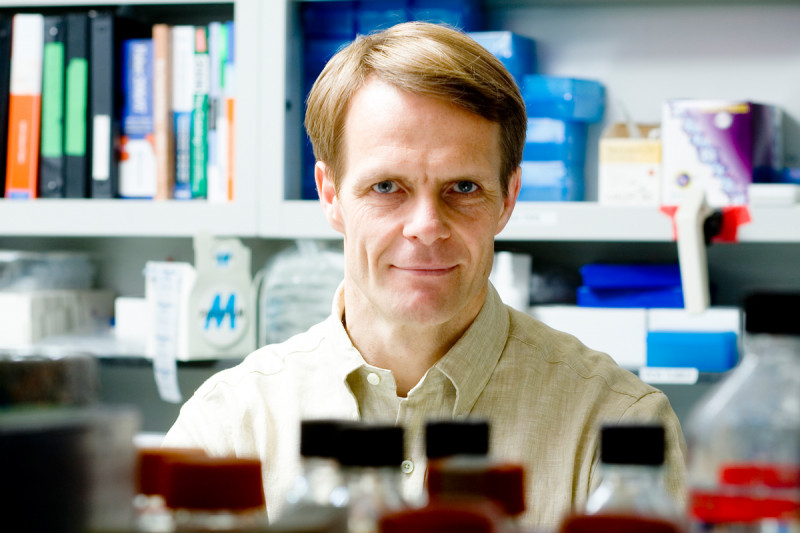
Lorenz Studer, MD -- Stem Cell Biologist
Lorenz Studer investigates human stem cells as tools to understand normal and pathological development in the nervous system and to develop cell-based therapies. We spoke with him in 2008.
My interest in medicine began when I was about 18. I had been in the hospital myself for an unusual type of bone infection and had also lost several close relatives to cancer. I decided to go to medical school, spending my first two years at the University of Fribourg and the latter four at the University of Bern. There, I met Christian Spenger, a neurosurgery fellow who thought we might be able to treat Parkinson’s disease in animals by implanting fetal tissue to yield healthy new brain cells. This idea of replacing damaged brain cells seemed revolutionary to me.
After I earned my MD degree in 1991, Christian and I set up a laboratory at the University of Bern. We were given a room that had been used to store brooms. But it was a good size, and we managed to get funding for the resources we needed.
We began tissue culture studies and developed ways to ensure quality control of the animal fetal tissue cells. I developed an assay to measure the cells’ ability to produce dopamine — the chemical whose deficiency causes the symptoms of Parkinson’s. We also studied the effects of proteins necessary for the growth of specific brain cells. Our early work culminated in 1995, when we implanted human fetal nerve cells into a Parkinson’s patient.
Immortal Cells
But I realized that fetal tissue would be difficult to acquire or to evaluate in thousands of patients. We needed to find a way not only to grow cells, but to make them multiply. At that time, an American researcher named Ronald McKay was learning to make cells immortal — enabling them to continue growing and multiplying. I wanted to couple his findings with emerging data on signals that control brain development.
I thought if we could grow stem cells in unlimited numbers, get them to mature — or differentiate — into specific types of cells, and then figure out how to give them to patients, we’d have the perfect system. That was my dream. So in 1996, I went to the National Institutes of Health to study with Ron McKay. I learned how to isolate neural stem cells and began seeking ways to make them mature into brain cells, called neurons.
By 1998, we had learned in animal studies how to take stem cells from the brain, grow them in culture, expand them, and give them instructions to differentiate. When we implanted them into mice with Parkinson’s disease, we were able to restore brain function. People were quite excited by this finding, and it is still the main paradigm for this kind of research. But we also realized that stem cells from the brain had limited potential, and that embryonic stem cells held more promise for differentiating into different cell types.
I came to the Sloan Kettering Institute in 2000. My wife and collaborator, Viviane Tabar, is a neurosurgeon and neuroscientist, and she had taken a position in Memorial Hospital. It may seem odd that a Parkinson’s disease researcher would end up at a cancer center. But I knew the signals that guide stem cells are in many cases closely related to those that drive cancer growth.
I also knew that certain cancer therapies, such as radiation therapy, can damage brain tissue, so finding a way to replace lost brain cells might be useful for people with cancer. Using stem cells to repair radiation damage has become the main focus of Viviane’s own research program.
Modeling Development and Disease
I set out to see if we could use stem cells to model development and disease. In the past eight years we’ve achieved some important milestones. In 2001, we showed how you could generate embryonic stem cells by taking DNA from the skin cell of a mouse, injecting it into an egg that has had its nucleus removed, and creating a blastocyst [a very early-stage embryo] from which we could remove embryonic stem cells. We later began working with human embryonic stem cells and, in 2004, learned how to encourage them to become specific types of nerve cells.
We’re currently collaborating with investigators from The Rockefeller University and Weill Cornell Medical College through the Tri-Institutional Stem Cell Initiative, which is funded by The Starr Foundation. The Initiative supports basic and clinical stem cell research projects and training opportunities. Our efforts were aided by the establishment last year of a new stem cell research facility at Memorial Sloan Kettering, also supported by The Starr Foundation through the Initiative.
In 2007, we reported how to coax human embryonic stem cells to develop into muscle cells that could potentially be used to repair musculoskeletal damage. In another recent study, we’ve shown how nerve cells created from mouse skin cells could be returned to the same mouse to treat its Parkinson’s disease; we learned that the cells must be genetically matched to restore brain function effectively. Mice that received stem cells derived from another mouse’s skin cells showed signs of chronic brain inflammation and did not regain function.
This year, we reported how we identified “rosette” neural stem cells — novel, very early-stage neural stem cells with an even broader potential to differentiate into the cells that make up the nervous system. We pinpointed the genes and signals that tell these cells to remain as rosette neural stem cells before differentiating.
Our findings have important implications for neural stem cell research and for applications in regenerative medicine. The study could also help us understand a type of childhood brain tumor called medulloblastoma, in which rosette formation is a key feature.

